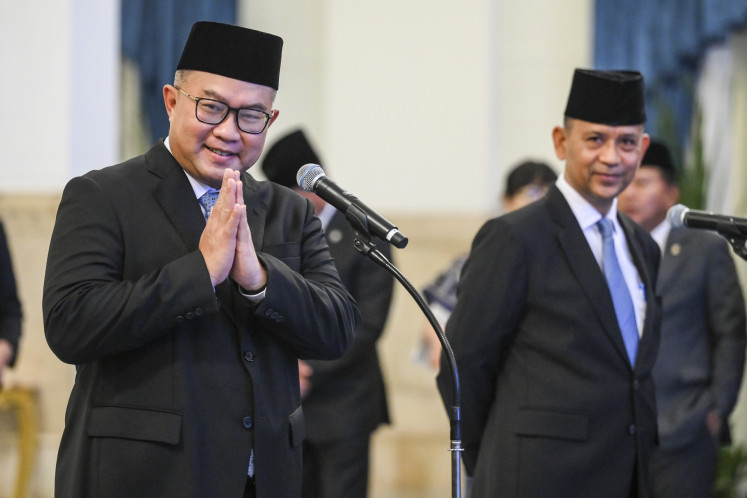Popular Reads
Top Results
Can't find what you're looking for?
View all search resultsPopular Reads
Top Results
Can't find what you're looking for?
View all search resultsKuta Karnival promotes traditional and modern art forms
Taking a stand: Local artists perform the Sekar Jagat dance during a cultural parade to mark the closing of the 7th Kuta Karnival on Sunday
Change text size
Gift Premium Articles
to Anyone
T
span class="caption" style="width: 399px;">Taking a stand: Local artists perform the Sekar Jagat dance during a cultural parade to mark the closing of the 7th Kuta Karnival on Sunday. The first Kuta Karnival was held as a show of defiance toward terrorists, a loud proclamation that Balinese tourism would survive. JP/Ni Komang Erviani
Wiwin, 22, a university student from Malang, East Java, struggled to take a photo amid the sea of people on Kuta Beach on Sunday.
She tried her best to squeeze through the crowd with her camera to take pictures of the passing cultural parade, which drew many observers and created prolonged traffic jams at streets leading to the renowned tourist destination.
It seemed that Wiwit and other spectators didn’t mind the scorching heat of the afternoon.
“I am very lucky to spend my holiday in Bali and to have the chance to watch a great cultural festival,” she said.
The street parade was part of the closing of the 7th Kuta Karnival, an annual celebration that has became a signature event of the tourism haven.
The first Kuta Karnival was organized in October 2003, just one year after terrorists bombed two popular night spots in the area.
The bombings killed 202 people, mostly foreigners, and almost put an end to Kuta’s reputation as a world-class tourist attraction. The first Kuta Karnival was a show of defiance against the terrorists, a loud proclamation that Kuta would survive.
This year’s festival was a rich presentation of the island’s traditional and modern art forms.
“Unlike previous festivals, which focused more on modern art, the 7th Kuta Karnival deliberately featured a balanced mix of the traditional and the modern,” said the head of the organizing committee, Ketut Nugra.
The decision to promote both traditional and modern art forms, he said, was in tune with the festival’s theme “Celebration of Life”.
“Kuta is a vibrant place where traditional arts and modern lifestyles exist side-by-side and this harmony is the concept we wanted to celebrate in this year’s Kuta Karnival,” Nugra stressed.
Throughout the festival, which ran from Sept. 19 to 27, spectators were spoiled with performances of traditional art forms, such as the iconic Kecak and the classical Legong dance.
“The festival also featured Mepantigan, a traditional Balinese martial art, and Gandrung, a joyful folk dance from Banyuwangi in East Java,” he added.
For spectators that wanted a taste of the modern side of Kuta, the festival featured graffiti art, body painting sessions and music concerts.
Two eco-friendly activities, a beach cleanup and the release of turtle hatchlings, were also part of the festival
In conjunction with the Kuta Karnival, local tourism establishments organized the Bali Food Festival from Sept. 25-27.
Food stalls were erected on the sandy beach of Legian and visitors were treated to a huge selection of Balinese traditional delicacies and western foods sold at bargain prices.
A meal, which would cost more than Rp 100,000 in a restaurant, was sold for Rp 35,000 at the food festival.
“We sold the products cheaply because the food festival was a promotional event,” said Bali Niksoma’s manager Nyoman Astama.










